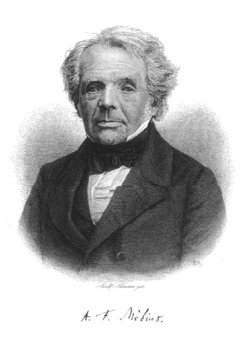August Ferdinand Möbius
| August Möbius | |
|---|---|
|
August Ferdinand Möbius (1790–1868) | |
| Born |
17 November 1790 Schulpforta, Electorate of Saxony |
| Died |
26 September 1868 (aged 77) Leipzig |
| Residence | Germany |
| Nationality | Saxon |
| Fields | Mathematician |
| Institutions | University of Leipzig |
| Alma mater |
University of Leipzig University of Göttingen University of Halle |
| Doctoral advisor | Johann Pfaff |
| Other academic advisors |
Carl Friedrich Gauss Karl Mollweide |
| Doctoral students | Otto Wilhelm Fiedler |
| Other notable students | Hermann Hankel |
| Known for |
Möbius strip Möbius transformations Möbius transform Möbius function Möbius inversion formula Möbius–Kantor configuration Möbius–Kantor graph |
August Ferdinand Möbius (German: [ˈmøːbi̯ʊs]; 17 November 1790 – 26 September 1868) was a German mathematician and theoretical astronomer.
Early life and education
Möbius was born in Schulpforta, Saxony-Anhalt, and was descended on his mother's side from religious reformer Martin Luther.[1] He was home-schooled until he was 13 when he attended the College in Schulpforta in 1803 and studied there graduating in 1809. He then enrolled at the University of Leipzig, where he studied astronomy under the mathematician and astronomer, Karl Mollweide.[2] In 1813 he began to study astronomy under the mathematically inclined professor Carl Friedrich Gauss at the University of Göttingen while Gauss was the director of the Göttingen Observatory. From there he went to study with Carl Gauss's instructor, Johann Pfaff at the University of Halle, where he completed his doctoral thesis The occultation of fixed stars in 1815.[3] In 1816 he was appointed as Extraordinary Professor to the "chair of astronomy and higher mechanics" at the University of Leipzig.[4] Möbius died in Leipzig in 1868 at the age of 77. His son Theodor was a noted philologist.
Contributions
He is best known for his discovery of the Möbius strip, a non-orientable two-dimensional surface with only one side when embedded in three-dimensional Euclidean space. It was independently discovered by Johann Benedict Listing around the same time. The Möbius configuration, formed by two mutually inscribed tetrahedra, is also named after him. Möbius was the first to introduce homogeneous coordinates into projective geometry.
Many mathematical concepts are named after him, including the Möbius plane, the Möbius transformations, important in projective geometry, and the Möbius transform of number theory. His interest in number theory led to the important Möbius function μ(n) and the Möbius inversion formula. In Euclidean geometry, he systematically developed the use of signed angles and line segments as a way of simplifying and unifying results.[5]
Collected works
- Gesammelte Werke erster Band (v. 1) (Leipzig : S. Hirzel, 1885)
- Gesammelte Werke zweiter Band (v. 2) (Leipzig : S. Hirzel, 1885)
- Gesammelte Werke dritter Band (v. 3) (Leipzig : S. Hirzel, 1885)
- Gesammelte Werke vierter Band (v. 4) (Leipzig : S. Hirzel, 1885)
See also
References
- ↑ Szpiro, George (2007). Poincaré's Prize: The Hundred-Year Quest to Solve One of Math's Greatest Puzzles. Plume. p. 66. ISBN 978-0-525-95024-0.
- ↑ August Ferdinand Möbius, The MacTutor History of Mathematics archive
- ↑ August Ferdinand Möbius, The MacTutor History of Mathematics archive
- ↑ August Ferdinand Möbius, The MacTutor History of Mathematics archive
- ↑ Howard Eves, A Survey of Geometry (1963), p. 64 (Revised edition 1972, Allyn & Bacon, ISBN 0-205-03226-5)
External links
| Wikisource has the text of a 1920 Encyclopedia Americana article about August Ferdinand Möbius. |
| Wikisource has the text of the 1911 Encyclopædia Britannica article Möbius, August Ferdinand. |
- O'Connor, John J.; Robertson, Edmund F., "August Ferdinand Möbius", MacTutor History of Mathematics archive, University of St Andrews.
- August Ferdinand Möbius at the Mathematics Genealogy Project
- August Ferdinand Möbius - Œuvres complètes Gallica-Math
- A beautiful visualization of Möbius Transformations, created by mathematicians at the University of Minnesota is viewable at https://www.youtube.com/watch?v=JX3VmDgiFnY
- Middle School Mathematician Project Short biography of Mobius by middle school students.
